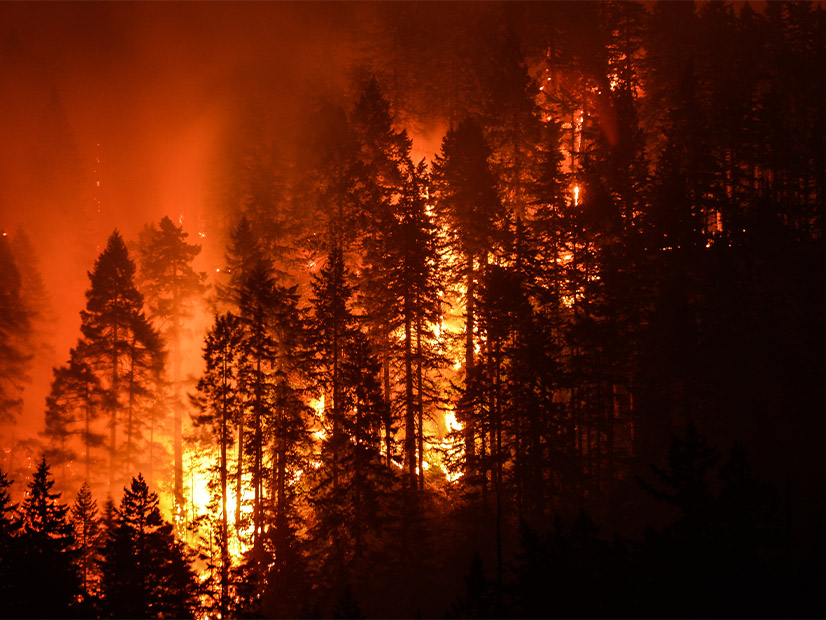
Increased wildfire risk in the Pacific Northwest has spurred utilities to adjust their operations to account for climate change and other contributing factors to better predict and fight fires going into 2025, utilities told the Oregon Public Utility Commission on Feb. 6.
There were 64,897 reported wildfires in 2024 that burned approximately 8.9 million acres nationwide, compared to 2.7 million acres in 2023. Oregon saw nearly 1.8 million acres burned due to wildfires, according to the National Interagency Coordination Center.
The “rapidly increasing impacts of climate change” are the predominant drivers behind the approximately 55% increase in wildfire risk in 2025 compared to 2024 risk models, Kellie Cloud, senior director of wildfire and operational compliance at Portland General Electric, said during OPUC’s wildfire workshop.
“Extreme weather events, drought and tree mortality all increase the potential for smaller fires to grow into destructive wildfires,” Cloud said.
The utility’s 2025 risk model also confirmed the importance of increased investment in system hardening and the effectiveness of PGE’s vegetation management, according to PGE’s presentation.
Some of PGE’s efforts already have paid off as it has reduced the size of certain high-risk zones by, for example, converting 8.7 overhead line miles to go underground and improving risk methodologies, Cloud said.
These efforts will continue into 2025, with PGE — which serves about 900,000 customers — planning to convert 26 line miles of overhead to underground, reducing ignition likelihood by addressing tree mortality and installing more wildfire detection cameras, among other things.
Similar efforts are underway by Idaho Power, which serves 20,000 customers in Oregon and another 650,000 across Idaho.
2024 marked an intense fire season for Idaho Power, said Jon Axtman, the company’s wildfire mitigation and transmission and distribution engineering director.
The utility saw 1,509,455 acres burned across its service area, which is about 175% above normal for the fire season in terms of acres burned, according to Idaho Power’s presentation.
“Wildfires in 2024 impacted the reliability of our customers as well, and we had 46 outages across the entire service territory that were either caused by fires burning into our lines, threatening or damaging equipment, or at the request of fire agencies to deenergize for safety purposes,” Axtman said.
He added that the utility also initiated its first ever full public safety power shutoff (PSPS) in 2024, which impacted thousands of customers.
The event led Idaho Power to reassess some of its operations, according to Axtman. For example, the utility installed more weather stations to gather wind speed data quickly instead of relying on publicly available data. Weather stations also could reduce the utility’s reliance on field observers in remote areas, he said.
Similar to PGE, Idaho Power will focus on system hardening in 2025, installing fire resistant wrap around transmission poles and building out its network of wildfire cameras, according to Axtman.
Representatives from PacifiCorp also participated in the wildfire workshop to discuss its mitigation plans in Oregon. The utility serves 623,000 customers in the state across nearly 21,000 square miles, about 14% of which is in high-fire risk areas, according to Melissa Swenson, director of PacifiCorp’s wildfire mitigation program.
Among the initiatives PacifiCorp has launched include expanding its fire risk model to cover its entire service territory, not just high-risk areas, and it has implemented a new PSPS forecast editor “to be more targeted about when a PSPS can happen,” Swenson said.
The utility also has increased its distribution hardening target from 125 miles in 2024 to 175 miles in 2025, and increased the number of fire season safety patrols, according to Swenson.
“Grid hardening is really the way to reduce the operational costs of the work, but also to improve the reliability,” Swenson said. “Because I think, you know, over time, if we have more hardening, maybe we don’t have to do the PSPS events.”


